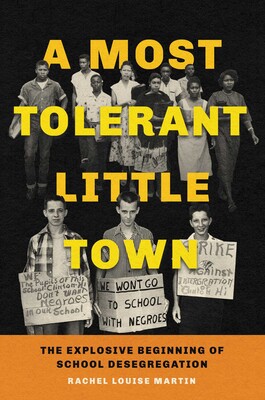A Most Tolerant Little Town: The Explosive Beginning of School Desegregation
- By Rachel Louise Martin
- Simon & Schuster
- 384 pp.
- Reviewed by Carr Harkrader
- June 22, 2023
How Clinton, Tennessee, responded to integration.

Like the Civil War that preceded it by a little less than a hundred years, the civil-rights period of the 1950s-60s is often recalled by the locations that shaped it: Manassas and Montgomery, Shiloh and Selma, Gettysburg and Greensboro. Each of those names, and many others, offer book-length lessons into America’s struggle with its commitment to freedom and equality. For the civil-rights movement, the locales are also sites of tangible liberty — cities and towns where something concrete was being fought for: a bus ride, a vote, a seat at a lunch counter.
In her new book, A Most Tolerant Little Town, Rachel Louise Martin argues that history has forgotten the events that happened in Clinton, Tennessee. The concrete thing being fought for there was access to a school. In 1956, a federal judge in Knoxville ordered, in accord with the U.S. Supreme Court’s recent Brown v. Board decision, that the all-white Clinton High School desegregate. Martin notes that “it was the first instance of court-mandated desegregation in the South, one year before Little Rock.” In August 1956, a dozen Black teenagers entered the double glass doors of the school as students for the first time. Martin’s book documents what happened next.
The white population of Clinton was unanimously against desegregation but split into two camps after the federal ruling: “law and order” people who (very) grudgingly accepted the decision and hardcore segregationists who resisted it at every turn. But there were also factions within factions. Getting involved in enforcing the decree helped some process-minded white Clintonians start to grasp the extent of the legalized bigotry facing Black families in town. Meanwhile, the segregationists often fought among themselves, especially the out-of-town bigots who showed up to rail against race-mixing and the local crowd that wanted to run a homegrown hate campaign. The racists, it seems, were arguing over who got credit for the ongoing persecution of Black people.
For their part, Black families, too, had their own reasons for demanding integration. Wynona McSwain, mother of incoming student Alvah Jay McSwain, had read the writings of Marcus Garvey as a teen and had long been advocating for better conditions for Black people in eastern Tennessee. Other Black families had moved to Clinton specifically to enroll their children in its post-Brown integrated schools. But as the first day approached, it was clear to all the Black residents what was at stake. As Martin writes when summarizing the thoughts of Herbert Allen, the father of student Jo Ann Allen:
“The conflict…boiled down to one simple question: either Black Americans were citizens of the United States or they were not.”
The answer to that question was very much unknown. In response to Black students stepping foot inside Clinton High School, a semi-organized white terror campaign began. There were riots, car chases, attacks inside the school, and eventually, a series of bombings against the Black community and its sympathizers. (Clinton is in coal country, and dynamite and other explosives were easily accessible.) The police were barely able to contain the rage of whites engaged in what was essentially guerilla warfare, and they offered no support to Black families under threat. As a result, these families formed their own self-protection unit, with armed men standing guard on porches in Freedman’s Hill, Clinton’s Black neighborhood. Reading the book, I sometimes wished for a set of maps to illustrate the skirmish sites.
The author quotes Bobby Cain, one of the Black students, reflecting on that tumultuous time: “I tried to forget everything that I carried at Clinton. I tried putting it in my unconscious mind.” Like war veterans, the Black students rarely talked to their own children later in life about what they’d endured; it was suggested that some of them may have developed a version of post-traumatic stress disorder.
Martin conducted oral-history interviews with Clinton residents over the course of many years, and it’s these recollections that form the book’s foundation. The author lets people speak for themselves, and their voices come through on the page, giving the narrative an emotional veracity not always found in works documenting the past. Thanks to the author’s descriptive storytelling, skillful pacing, and respect for her subject, A Most Tolerant Little Town offers a vivid portrayal of Clinton High School’s long-ago desegregation and the lingering consequences of racism in Tennessee and across the nation.
Carr Harkrader is a writer and book critic in Chicago. You can follow him on Twitter at @CarrHark.

